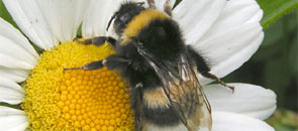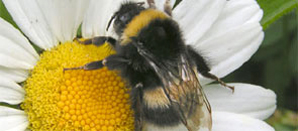 Summer is in bloom. Walk through the countryside in late May and there is a heady mix of different smells to greet the senses.
Summer is in bloom. Walk through the countryside in late May and there is a heady mix of different smells to greet the senses.
Some flowers, such as the white blossom on the apple tree, have a sweet and delicate fragrance. Others, like the wild garlic that is flowering amongst the trees on the bank of the stream, have a stronger scent. Wild garlic has beautiful white flowers that always remind me of twinkling stars. It is the succulent leaves that give the strong aroma when they are crushed. One of the most distinctive scents at this time of year is the oilseed rape that is in flower, vast fields of shimmering yellow.
Watching a bumblebee delicately tunnelling into a purple comfrey flower, the insect is completely enclosed by the petals. He drinks the nectar, the sweet taste of midsummer. I wonder if this insect can perceive the fragrance of the flowers that he visits. An interest in natural history often poses such questions. The more I learn, the more I realise that I do not know.
A bit of research tells me that bumble bees actually use scent to communicate. These insects will forage on a wide range of different flowers, all with varying amounts of nectar and pollen. When a bumblebee finds a good nectar source, they need to tell other members of the nest. To do this they carry the scent of the flower on their body and scented nectar in their stomach. They then run excitedly around the nest to get the attention of the other bees.
The bees then use the scent to recognise the nectar source. After discovering this, I start to think about what other senses invertebrates use to perceive their surroundings.
The old field gate is hanging on a wooden post that is riddled with cracks. It is a sunny day and a range of different flies are basking on the south-facing side of the post. I suddenly spot a small spider. It has a black body with white stripes and it is wrestling a large fly. This is a zebra spider. It lives in one of the cracks in the wooden post. It is a type of jumping spider, so does not rely on a web to catch prey. It stalks flies and then jumps onto them. It has 8 eyes including 2 very large ones at the front of the head. The eyesight of a jumping spider is one of the best in the invertebrate world. Of course, the flies that spiders feed on also have excellent eyesight because of their huge compound eyes.
The sound of grasshoppers chirping in a meadow is an evocative sound of high summer. The tympanum is a large round disc on the abdomen of the grasshopper. It consists of processors and nerves that are used to monitor the air for vibrations. It is the equivalent of the human eardrum and allows the grasshopper to detect sounds. Male grasshoppers make their characteristic noise by rubbing their back leg against their wing. They have different songs to mark out a territory, or to attract a mate.
Demonstrating a sense of taste in invertebrates is slightly harder as they often lack the mouthparts and taste buds of more complex animals. However, the meadow brown butterflies that we see at this time of year actually taste through their feet. Meadow brown caterpillars feed on grasses but the adult insect feeds on nectar from flowers such as buttercups and thistles. The adults need to ensure that they lay eggs on the correct plant, but do not have mouthparts that allow them to taste the plants. This is why they have chemoreceptors on the bottom of their legs.
Many caterpillars are covered in long hairs. These are called setae and they penetrate the hard skeleton on the outside of the body. The setae are attached to nerve cells and allow the caterpillar to sense touch. The setae are also present on the adult butterfly (giving the body a hairy look). These help the butterfly to sense wind direction when flying.
The world of invertebrates is hidden under the hedgerow, lurking amongst the flowers and hiding in the log pile. To discover their secrets is to uncover a fascinating range of body shapes, adaptations and life histories. It is easy to think that lacking a back bone makes invertebrates basic animals. I have discovered that, in fact, they have evolved many different ways in which to sense the world around them. They have adapted to some of the harshest conditions on the planet and are an extremely successful group.
Bill Vaughan sums this up with the following quote,
“We hope that, when the insects take over the world, they will remember with gratitude how we took them along on all our picnics.”
Do one thing for wildlife this month:
Why not help the invertebrates in your garden by building a bee nesting box? Simply take some bamboo canes and cut them so that long hollow sections are exposed. Tie the canes into a bundle and hang in a sunny place in the garden. Many types of solitary bee will nest in the tubes and pollinate your garden plants! For more details see:
www.buglife.org.uk/getinvolved/gardening/beenestsforgardeners
Each month we will be following the seasons around us, featuring the What’s What Wildlife Diary with our nature expert, Edward Andrews, MSc.






